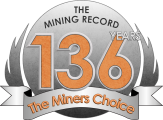Break-Through Geophysics Pinpoints Roll Front Targets At Agate
KELOWNA – Strathmore Plus Uranium Corporation reported on the on-going geophysical study completed by the University of Wyoming (UW) at the Agate project. The UW’s research will give Strathmore specific targets for their 200-hole drilling program this spring and provide opportunities to locate roll fronts, the “noses” of which are anticipated to host thicker intervals and higher grades of mineralization. Agate is envisaged as an ISR project located in the Shirley Basin Uranium District in Wyoming.
Sam Hartmann, P. Geo., said, “Strathmore is successfully demonstrating the viability of using the unique approach of ground geophysics in a roll front environment, with resistivity emerging as a tool to potentially map alteration systems associated with mineralization. If we can continue to identify these typically sinuous roll front bodies on a larger scale as demonstrated with this case study, it stands to provide discrete targeting for the upcoming spring drill program. The current resistivity inversion in profile represents first order targeting on section and will complement our ongoing efforts to digitize and incorporate the significant amount of historical drill hole data by Kerr-McGee into the property model.”
The research by Dr. Bradley Carr, Director of UW’s Near-surface Geophysical Center (UWNSG), consists of ground and borehole geophysics applied across the project to detect and image a uranium roll front and possibly monitor the movement of the roll front’s position during future in-situ mining development. Strathmore looks forward to working with Dr. Carr to provide potential targets for the 2024 exploration season based on the geophysical study completed in 2023 and UW’s more extensive research study slated for 2024.
Carr said, “Since early 2023, the University of Wyoming’s Dept. of Geology and Geophysics (G&G) was funded by the State of Wyoming and the UW School of Energy Resources to conduct research into geophysical characterization tools of sedimentary deposits of uranium. In this project, Dr. Carr and two UW G&G graduate students partnered with Strathmore Plus Uranium to study the shallow, near-surface uranium roll front at their Agate Prospect in Wyoming’s Shirley Basin. The goal is to study and determine which geophysical tools provide the best delineation methods for sedimentary uranium roll fronts which are found within the sedimentary geologic layers in Wyoming, Colorado, New Mexico, Texas, and Utah.
The preliminary results of the study illustrate how a combined geophysical method study including both surface and borehole geophysical methods highlight the roll front location, unaltered areas ahead of the roll front, and altered areas behind the roll front. In this research, the borehole and surface geophysical methods include seismic reflection, seismic refraction, DC resistivity (ERT), Induced Polarization (IP), Electromagnetics (TEM), Self-Potential (SP), and Nuclear Magnetic Resonance (NMR).
In traditional uranium exploration and characterization, radiometric surveys followed by drilling and borehole gamma logging are the standard approaches. Although fine, additional geophysical methods can provide more detail on the location, quantity and background groundwater condition allowing more advanced extractive planning and engineering prior to production.
To date in this geophysical study for sedimentary uranium deposits, we have collected preliminary surface data for TEM, ERT and IP, SP, and borehole datasets of Spectral Gamma, Normal resistivity/IP/SP, and NMR. The methodology utilized in 2023 during the preliminary phase of this research. In 2024, we will continue to collect additional TEM, seismic reflection/refraction, and ERT/IP profiles at the site to further delineate the geophysical response of the uranium roll front and potential channel sand where it is hosted. 2023 data analyses and field planning for summer 2024 is continuing currently. Additionally, we will collect NMR datasets to study the mobile groundwater and porosity/permeability state of the target sands. Finally, we will collect and analyze ‘full-waveform’ Induced Polarization (IP) data to determine how viable IP is for identifying not only the location of the active roll-front but if it can tell us about the material state in-front (unreacted) and behind (reacted) parts of the system surrounding the active roll-front. We are encouraged about the use of IP data generally from preliminary, traditional IP surface and borehole data collected in 2023. However, the addition of ‘full waveform’ analyses of the IP decay should provide even greater insights into the in-situ state of the uranium roll front which will hopefully aid development and production planning.”




Comments (0)